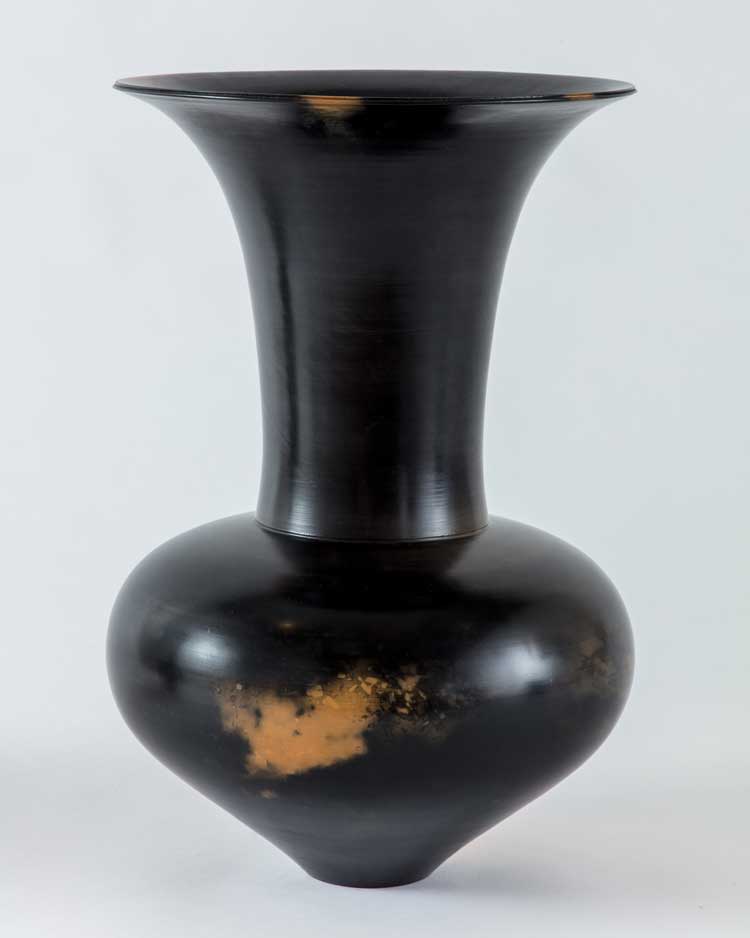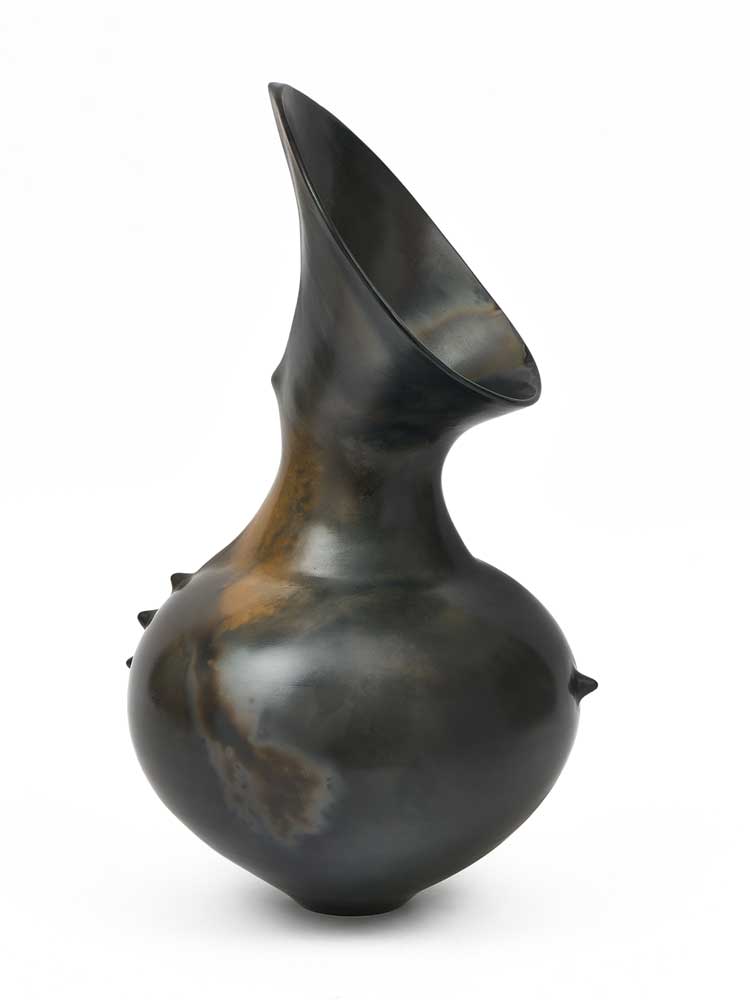.jpg)
Magdalene Odundo, installation view, Thomas Dane Gallery, London. © Magdalene A.N. Odundo. Courtesy the artist and Thomas Dane Gallery. Photo: Ben Westoby.
Thomas Dane Gallery, London
9 October – 14 December 2024
by BETH WILLIAMSON
The economy of this exhibition of work by Magdalene Odundo is disarming. Yet despite being composed of just three drawings and six vessels, this small exhibition has so much to say about Odundo’s achievements. With her exhibition at Houghton Hall in Norfolk just ended, this is the artist’s first solo exhibition in London for more than 20 years. Displayed without the intervention of glass, or the complex historical context of Houghton Hall to negotiate, the presentation of Odundo’s work is here stripped back. The elegance of the forms belies their strength and ability to be carriers of important histories. Quietly dignified in their demeanour, these six vessels (for they are vessels, not pots) and three preparatory sketches, all completed between 2020 and 2023, represent something of a concise summary of Odundo’s 30-year-long career.

Magdalene Odundo. Untitled Vessel, Symmetrical Series, 2020. Ceramics, terracotta, 46.5 x 30 x 30 cm (18 1/4 x 11 3/4 x 11 3/4 in). © Magdalene A.N. Odundo. Courtesy the artist and Thomas Dane Gallery. Photo: Richard Ivey.
Odundo (b1950) originally trained in graphic design at the Kenya Polytechnic in Nairobi, then, in 1971, moved to the UK where she studied at the Cambridge School of Art (now Anglia Ruskin University), the University for the Creative Arts in Farnham and at the Royal College of Art (RCA). Encouraged by Eduardo Paolozzi at the RCA, Odundo visited the British Museum where she was attracted to Christopher Dresser’s hybrid ceramic vessels of the 1880s, which drew on multiple sources to create something fresh and exciting. Dresser recommended the study of what had gone before, not to copy but to learn, to search out “general truths and broad principles”. That is a principle Odundo has adhered to since she graduated in 1982. While in Cambridge she frequently visited the Fitzwilliam Museum where Egyptian-Kerma beakers with black and red surfaces, an effect achieved through reduction firing, sparked her imagination and later inspired her own distinctive black and red patinas and techniques. Yet this remains just a single point of reference for the artist. Her cross-cultural influences and touchstones are broad as she has looked to European modernism, Bernard Leach in Japan, Maria Martinez in New Mexico, and studio visits with Michael Cardew, who encouraged her to visit the Pottery Training Centre in Abuja, Nigeria, where she was taught by Ladi Kwali and others.
Odundo is known for the distinctive vessels that draw on her myriad interests in historic and contemporary making across different cultures, vessels that approach and transcend the condition of sculpture. Burnished, not glazed, Odundo’s vessels are made over a period of months, kept in vats of water in between multiple periods of being worked on until their forms are resolved to her satisfaction. Then, they undergo multiple firings. In her explorations of diasporic identity in her making, Odundo uses traditional methods and processes for her hand-built sculpture, methods that emerged from her residency at Abuja where she learned how to hand-build in the traditional Gbari method, traditionally practised by female potters.
.jpg)
Magdalene Odundo, installation view, Thomas Dane Gallery, London. © Magdalene A.N. Odundo. Courtesy the artist and Thomas Dane Gallery. Photo: Ben Westoby.
The vessels are replete with anthropomorphic references, often to the female body – nipples, navels, mouths, necks, spines, skins. For Odundo, this is inevitable. As she explains it: “The human body is a vessel that contains ourselves, our being human. As artists and makers of things, when we are sculpting, modelling or forming figures or containers, we are echoing the vessel that is us as human containers of mind and body.” Referencing the natural and the man-made in her making, Odundo blends forms in these profoundly affective vessels. Each work begins with a ball of clay that she hollows out and pulls upward and builds height with the addition of short lengths of flattened clay.
They are hand built, she says, because that is a slower process than throwing on a wheel. That slowness allows her time to think about what she is making, to recall myriad memories and weave them into the work in one way or another. Her method of hand-building also means the work is static, so she moves around it, shaping and animating the clay from all sides.

Magdalene Odundo. Untitled, 2021. Ceramics, terracotta, 48 x 32 x 32 cm (19 x 12 1/2 x 12 1/2 in). © Magdalene A.N. Odundo. Courtesy the artist and Thomas Dane Gallery. Photo: David Westwood.
The six vessels in this exhibition are placed in conversation with one another, their openings and bodies in dialogue. The work-in-progress sketches included here all show pairs of vessels, allowing for that dialogue even as their forms are worked out, although the final resolution in clay may result in something different as Odundo allows the material to lead her and the vessels to breathe. Yet that dialogue between vessels is not only among themselves, but with Odundo’s strands of influence and touchstones. For instance, the studs or protrusions that adorn some of the vessels, and often referred to as nipples by commentators, recall the studded decoration Odundo would have found on the works by Dresser at the British Museum, such as his urchin vessels made in the 1880s for Linthorpe Pottery.

Magdalene Odundo. Untitled, 2023. Ceramics, terracota, 60 x 32 x 32 cm (23 1/2 x 12 1/2 x 12 1/2 in). © Magdalene A.N. Odundo. Courtesy the artist and Thomas Dane Gallery. Photo: David Westwood.
Extending that layer of reference yet further, she could also see aspects of Peruvian stirrup pots in Dresser’s work. In Odundo’s own vessels, Cardew, Kwali and many others, all make appearances, if you look hard enough. Yet while Odundo has developed a language that is informed by her understanding of the past, she also intends to show “the global world that we live in”. Therefore, Odundo’s sculptural language transcends time and place. For her they are universal: “The vessel is present from birth to death. We’re brought in through a vessel and we leave in a vessel. I think that’s why the idea of embodiment, and representing an individual, has also been so poignant when thinking about and appreciating the pot as a universal object.” Her unique sculptural language is what is clearest in this exhibition. Freed from the noise of particular contexts, Odundo’s work articulates quietly and with balletic poise.